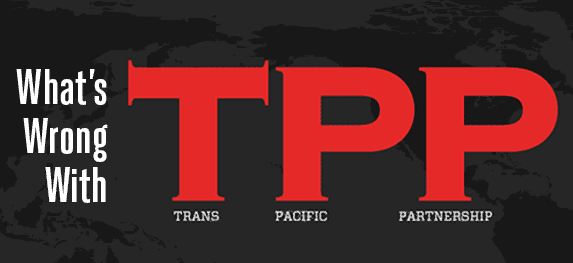TPP Trade Deal Being Sold With Bogus Economic Models
The Trans-Pacific Partnership Trade deal is terrible even apart from its quantifiable economic effects, as it threatens our environment, our health, our democracy, our sovereignty, our security and many other things. But it is also a lousy deal on the pure economics, which is why it is currently being sold to the American people and Congress using bogus economic analysis.
Much of this is analysis is highly technical, and thus somewhat difficult for non-economists to critique, but let me give at least a conceptual sketch of what’s wrong with it. (Here’s a more technical critique if you want one.)
As documented at length in my book Free Trade Doesn’t Work, most of the economics used to justify free trade and free-trade agreements makes sense if you grant its intellectual premises, which tend to be buried. Feretting out these hidden assumptions — I identified the eight big ones in my book — is thus the master key to understanding how we’re being snowed.
Related article: The Trans-Pacific Partnership Trade Deal Is a Disaster[p][/p]
All free-trade economics rests ultimately upon the famous Theory of Comparative Advantage, invented by British economist David Ricardo in 1817. In order to assign actual dollar amounts to the purported benefits of free (or freer, which is usually what is at issue) trade, economists generally use computerized “computable general equilibrium” (CGE) models built upon Ricardo as the foundation.
These models are called “computable” because, unlike economic models that exist purely to prove theoretical points, it is possible to feed actual numbers into them and get numbers out the other end. They are called “general equilibrium” because they are based on the core idea of market economics: the economy consists of a huge number of separate equilibria between supply and demand and all these markets “clear,” or match supply with demand, at once.
These models, including many of the ones being used to peddle TPP right now, tend to make some rather dubious assumptions.
Related article: Free Trade: The Theory That’s Killing America’s Economy — and Why It’s Wrong[p][/p]
For example, they assume that government budget deficits and surpluses will not change due to the impact of trade, but will remain fixed at whatever level they had in year zero of the model.
They also assume that trade deficits or surpluses will be similarly stable, with exchange rates fluctuating to keep them constant. This is empirically untrue: exchange rates often over-react to events and take time to find a rational level, and financial (as opposed to trade) factors can push them out of alignment with trade fundamentals for extended periods. And that’s not even considering deliberate currency manipulation, a huge element in the policies of export superpowers like Germany, Japan and China.
These models also assume that a nation’s investment rate will equal its savings rate: every dollar saved will flow neatly into some productive investment. This is basically a form of Say’s Law, “supply creates its own demand,” named after the French economist Jean-Baptiste Say (1767-1832). This makes both under-investment and unemployment theoretically impossible–a tell-tale sign of an inappropriate assumption.
Related article: Currency Bill Is a Small Victory Against Currency Manipulation[p][/p]
Furthermore, many of these models assume that nations enjoy magical macroeconomic stability: the business cycle has been mysteriously abolished.
And their financial systems will enjoy unruffled tranquility, without booms, busts, or bubbles. (And in any case, free-trade agreements will have no effect, despite the TPP interfering with the ability of nations, including the U.S, to regulate their financial sectors.)
The above assumptions are understandable, as devices to simplify models enough to make them teachable to undergraduates. They are, however, somewhere between profoundly controversial in their own right and flatly empirically false.
They are also profoundly pre-Keynesian (as in Maynard Keynes, the British father of modern macroeconomics) and thus at least 70 years behind mainstream domestic economics.
This is a recurring problem in free-trade economics: ideas long discarded in other areas of economics recur with puzzling regularity. Nobody, liberal or conservative, believes in absolute free markets domestically anymore (whatever their after-dinner speeches to the contrary), but the minute we consider international trade, the robber-baron attitudes of the 1880’s come roaring back. One can almost hear the gold watch-chains clinking!
Related article: TPP: What’s At Stake With The Trade Deal?[p][/p]
These models also generally leave out transition costs.
These sound temporary, but such transitions can take decades: consider the harm suffered by the Midwestern manufacturing areas of the U.S. as their industries have gradually lost comparative advantage since the mid-sixties.
Given that the world economy is not static, but constantly moving into new industries, there are always new transitions being generated, which means that transition costs go on forever, as an intrinsic cost of having a global economy based on shifting patterns of comparative advantage. Somebody will always be the rustbelt.
This does not, of course, mean that economic change is a bad thing, but it does mean that these costs must be factored in to get an accurate accounting. For example, the standard way for free traders to play down the damage done to the victims of free trade is to count only workers directly displaced from jobs as its losers. Unfortunately, these workers crowd into the labor market of everyone else with similar education and skills, dragging down wages for them, too.
Another caveat: because all these models are predictions about the future, they are necessarily speculative under the best of circumstances and notoriously susceptible to deliberate manipulation. Remember how the glowing predictions about NAFTA turned out? Remember how establishment economists laughed at Ross Perot’s prediction of a “giant sucking sound” of U.S. jobs being lost?
It is easy, for example, to generate inflated predictions of gains from trade (which are then used to offset expected losses) by extrapolating calculations intended to apply only within certain limits with back-of-the-envelope calculations that go far beyond these limits. (These are known in the trade as “hockey stick” projections due to their shape when graphed.) So as Frank Ackerman of the Global Development and Environment Institute at Tufts University puts it:
The larger estimates still being reported from some studies reflect speculative extensions of standard models, and/or very simple, separate estimates of additional benefit categories, not the core results of established modeling methodologies.
Even if all statistical gamesmanship is removed and other reforms made, there is a deeper problem with CGE models: no such model can predict what choices of trade strategy a nation will make. For example, none of the models used in the 1950s predicted Japan’s subsequent ascent to economic superpower status, nor did any models predict China’s ascent since 1990.
Related article: TPP Trade Deal – 4 Ways it Will Affect Your Dinner Plate[p][/p]
Quite probably, no model based upon purely free-market assumptions ever could have, as pure-free-market economics, with its insistence that it is always best to just do what the free market says, rules out a priori the possibility that most such deliberate economic strategies can ever work.
This leads to a larger point, about why economists (as opposed to vested interests) tend to get free-trade economics wrong.
Theories which favor free trade tend to be mathematically neat–mainly because they assume markets are perfectly efficient, which makes their outcomes predictable. Theories which critique free trade, on the other hand, tend to be mathematically messy, mainly because they assume markets are not perfectly efficient and are thus not predictable. So economists have often favored free trade simply because the math is neater. As Paul Krugman puts it, “the theory of international trade followed the perceived line of least mathematical resistance.”
Sorry, but there’s too much at stake to make mistakes like this.
SOURCE: Huffington Post





ok, so now what? surley you know what to do so just do it ok?